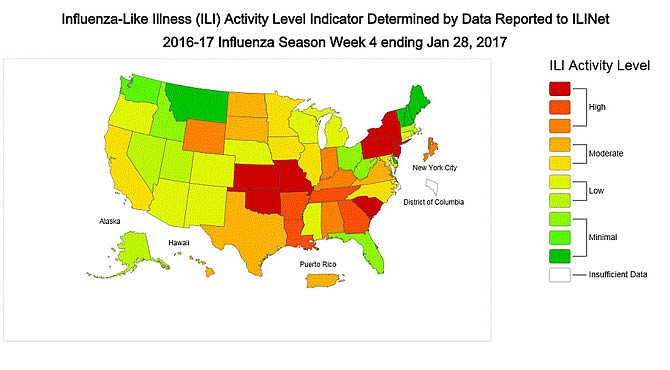Missouri is one of seven states currently at the highest level of flu activity in the nation, with 24 influenza or influenza-like (ILI) outbreaks reported last week.
Missouri joins New York, Kansas, Oklahoma, South Carolina, Pennsylvania and New Jersey with the highest of 10 activity levels of influenza, according to the latest FluView Report, ending in the week of Jan. 28, from the Centers for Disease Control and Prevention (CDC).
The state's percentage of respiratory specimens positive for influenza in clinical laboratories increased during the week of Jan. 29 through Feb. 4, according to the Missouri Department of Health and Senior Services (DHSS). During that week, seven influenza-associated deaths and four influenza or ILI-associated school closures were reported.
During the week ending Jan. 28, 87 deaths involving pneumonia and influenza were reported to the Bureau of Vital Records, resulting in a season-to-date total of 1,052 pneumonia and influenza deaths in Missouri.
A season-to-date total of 20,400 laboratory-positive influenza cases (17,070 influenza A, 2,933 influenza B and 397 not typed) have been reported in Missouri as of last week.
Most laboratory-positive cases have been among children ages infant to 4.
The Central Missouri district, which includes Cole, Miller and Morgan counties, has seen 2,525 laboratory-positive influenza cases since flu season officially began in early October.
The central district has the second-lowest flu incidence season-to-date, more than the southwest district but behind the southwest, northwest and eastern districts.
"Cole County is seeing more cases in the last few weeks, but this season has still been relatively mild," Kristi Campbell, director of the Cole County Health Department, said.
During the week ending Feb. 4, 709 flu cases were reported in the central district.
The central district has seen an increase in flu cases recently, as reported by DHSS and the Cole and Miller county health departments. Cole County saw 46 laboratory-positive influenza cases, Miller County saw 10 and Morgan County saw 23, according to last week's DHSS flu report.
Season-to-date, Cole County has had 245 flu cases, Miller County had 152 and Morgan County had 92.
Miller County Health Center Administrator Bruce Jenkins said he also has seen an increase, but within the last week, flu reports have started to drop within the county.
"We have also seen more younger people getting the flu," he added. "Seniors are more likely to get their flu shots, primarily because their doctors say they need them."
Even though reported flu cases have increased across the state, Jenkins said they are often higher this time of year.
"We are in the peak of flu season, which usually is in late January and early February," he said. "More people are just getting the flu."
Influenza is a respiratory illness that hits suddenly and brings fever, cough, sore throat, fatigue and muscle aches. If symptoms are prevalent, health professionals recommend getting treated right away.
"If you think you have the flu, see your doctor and ask about antiviral drugs," said Dan Sabourin, registered nurse from Lake Regional Occupational Resources, in a news release. "People at high risk for flu complications and people who are very sick with the flu should get antiviral drugs. Some other people can be treated with antivirals at their health care provider's discretion. Treatment works best when begun within 48 hours of getting sick but still can be beneficial when given later in the course of illness."
The CDC recommends annual flu vaccination for everyone 6 months of age and older and encourages anyone who has not gotten vaccinated yet this season to do so now.
Many county health departments still have flu vaccines available for residents, as well as clinics, pharmacies and grocery stores.
Miller County Health Center still has about 80 flu shots available, with appointments recommended and walk-ins available. However, the center does not carry as many flu shots during the peak season as in previous years because so many other places now make flu shots readily available.
"We use to give out 2,000-plus flu shots a year. Now we are down to 400 flu shots. Grocery stores, pharmacies, clinics, and big stores like Walmart and Target make it so convenient for folks now," Jenkins said. "However, we will always still have flu shots here during the season."

